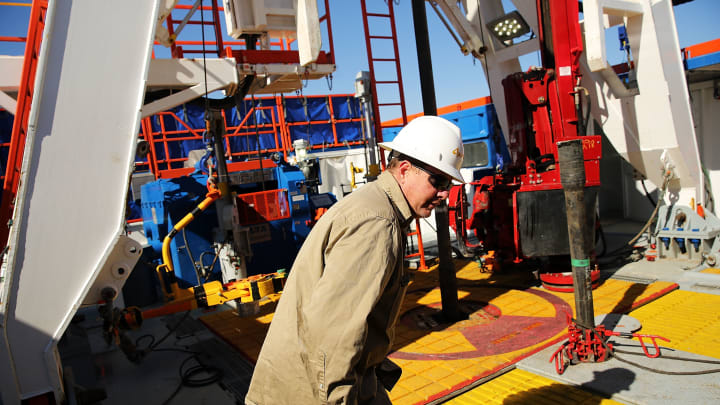As markets for energy companies’ bonds crater on lower crude oil prices, bond analysts offer one big piece of comforting news amid the chaos: Very few major energy companies have any debt due before next year, when the crisis sparked by the COVID-19 coronavirus is likely to be over.

Bond markets have joined stock investors in panic since mid-February, pushing yields on 10-year U.S. treasurys to historic lows, and widening the spread between yields on treasuries and low-rated corporate debt, known as junk bonds, to nearly 7 percentage points. Most credit spreads are at levels not seen since 2016. The Federal Reserve stepped in Thursday, announcing it will pump $1.5 trillion in liquidity into the financial system through treasury purchases and other moves.
There’s little to suggest that a credit crisis is brewing, even in the oil and gas sector, which has been hit hard by coronavirus and the simultaneous spat between Saudi Arabia and Russia over oil production quotas that has sent crude oil prices down by a third, to $33 a barrel, on the Saudis’ promise to boost production. While the sector is known for a large number of companies with big debt loads or low bond ratings, analysts say a near-term spike in defaults isn’t likely.
`It’s tricky to watch the granular details,” CFRA Research energy strategist Stewart Glickman said. “Even if a company has a lot of debt, if it’s not maturing they can buy themselves a window of time.″
When the energy debt is coming due
Of $86 billion in debt that exploration and production companies have to refinance or repay by 2024, only $5.3 billion is due this year, and only $1.7 billion of that is junk. The biggest chunk is due in 2022, at $25.7 billion.
Only 10 companies in the exploration and production sector, the most vulnerable part of the business, account for nearly half of the debt coming due by 2024, Moody’s said. The biggest is Occidental Petroleum at $14 billion of its $40 billion in long-term debt. None of it is due this year, though, according to Oxy’s Securities and Exchange Commission filings. The company has until 2021 and 2022 to make most of its repay-or-refinance decisions. The debt load is related to Oxy’s acquisition last summer of Anadarko Petroleum, which has been criticized and continues to attract activist attention.
“They’re certainly the poster child for taking on a very large acquisition at the wrong time,” said Glickman.
Carl Icahn, who called it one of the worst deals he has ever seen, recently told the Wall Street Journal he had increased his stake in Occidental Petroleum to 10%.
Analysts at Standard & Poor’s say that bond defaults this year are the same as last year, at 20 through March 5, with only two from oil and gas. They expect bond ratings to weaken as more companies see their credit ratings cut, with 33% of energy sector bonds under review for downgrade, versus an average of 19% historically.
[contextly_sidebar id=”f01rMkOwn5we1F6Fuhy791hQjFXDkbsg”]
Moody’s has similar numbers. Only 3.1% of junk bonds have defaulted in the last 12 months, and much of the value of the bonds will be recovered, the firm said. They only expect it to rise to 3.5% this year, well below the historical average of 4.1%, the firm said in a March 10 report. Even oil and gas bonds only have a 3.5% default rate, and only 3.1% in the U.S., Moody’s reported. Investment grade bonds virtually never default, since signs of financial trouble typically lead to companies’ bond ratings falling into the junk pool before they miss payments or go broke.
Both S&P and rival Moody’s Investor Service expect overall junk bond default rates will remain below the long-term average of 4.1% this year.
Conserving cash in crude crash
Most issuers have plenty of steps they can take to conserve cash as crude prices cut into cash flows already stretched by the heavy investment needed rapidly to expand U.S. drilling capacity through hydraulic fracking.
Occidental Petroleum, in which Warren Buffett’s Berkshire Hathaway owns a stake, said it was cutting its common-stock dividend by 86% to conserve cash. Berkshire owns many preferred shares which receive a special dividend, unaffected by the cut on common share dividends. Occidental spent more than $2.5 billion on dividends last year, more than double the amount in spent on interest payments on its $40 billion of long-term debt.
Energy-exploration companies also can cut into the expense the market has most focused on, which is investment in new wells. At many companies, this investment is more than the short-term cash flow the companies’ existing wells are generating. The 38 fracking companies studied by the Institute for Energy Economics and Financial Analysis in November had a total of $4.9 billion in negative free cash flow during the 12 months that ended Sept. 30.
Apache Corp., one of many companies cutting capital spending to ride out the storm in crude markets, said Thursday that it would cut its capital spending budget for this year by more than a third, to a range of $1 billion to $1.2 billion, down from a previous range of $1.6 billion to $1.9 billion. Apache generated a $90 million free-cash-flow loss in 2019, and spent an additional $376 million on dividends. The company has slashed its dividend from $0.25 to $0.025, saving an estimated $340 million. The $1 billion saved by cutting capital spending and the dividend is more than double Apache’s 2019 interest payments of $437 million.
“Of the $53 billion in speculative-grade debt maturities through 2024, less than $2 billion will mature in 2020, with $9 billion maturing in 2021 and at least $12 billion annually during 2022-24,” Moody’s analysts led by Sajjad Alam wrote. The delayed speculative-grade debt maturities should provide some relief to lower-quality and natural gas-producing E&P companies, which were either shut out of the refinancing market or paid very high interest costs to issue debt in 2019.”.
Banking sector risk levels
At the same time, the biggest U.S. banks, marked by regulators as globally significant financial institutions, have built up capital cushions since the 2008 financial crisis that are much larger than their exposure to the energy sector, so they are reasonably well insulated against an oil downturn. But regional banks in the Southwest are heavily exposed, according to a report by Keefe Bruyette & Woods.
The top four U.S. commercial banks (J.P. Morgan Chase, Citigroup, Wells Fargo and Bank of America) each had total energy exposure of less than 15% of their tangible common equity, the firm’s analysts reported. That suggests their energy loans could go to zero without threatening the survival of the biggest banks.
Among the most exposed are banks like BOK Financial and Bank7 Corp., whose energy exposure is more than their total common equity, Keefe Bruyette asid. Eleven small and mid sized banks have oil and gas loans at least equal to 25% or more of their equity.
“For the largest U.S. banks, it will not be significant, but it’s likely to be called out on their [quarterly[ conference calls,” CFRA bank analyst Ken Leon said. “The emphasis for banks has been more about the corona exposure, especially in China.”







